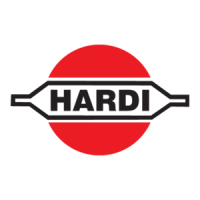7 - Fault finding
78
Liquid system
FAULT PROBABLE CAUSE CONTROL/REMEDY
No spray from boom when turned on. SmartValve positions wrong. Set correct valve positions for spraying.
Suction/pressure filters clogged. Clean suction and pressure filters.
No suction from tank. See if suction fitting in main tank sump is free of
sedimentation.
Lack of pressure. Incorrect assembly. Boost valve is open.
Air in system. Fill suction hose with water for initial prime.
Too much agitation. Close the agitation valve.
Pump valves blocked or worn. Check for obstructions and wear. Replace if necessary.
Blocked filters Clean all filters.
Defect pressure gauge. Check for dirt at inlet of gauge.
Pressure dropping. Filters clogging. Clean all filters. Fill with cleaner water. If using
powders, make sure agitation is on.
Nozzles worn. Check flow rate and replace nozzles if it exceeds 10%.
Sucking air towards end of tank load. Lower pump r.p.m.
Pressure increasing. Pressure filters beginning to clog. Clean all filters.
Formation of foam. Air is being sucked into system. Check tightness/gaskets/O-rings of all fittings on
suction side.
Excessive liquid agitation. Reduce pump r.p.m.
Check safety valve is tight.
Ensure returns inside tank are present.
Use foam damping additive.
Liquid leaks from bottom of pump. Damaged diaphragm. Replace. See changing of valves and diaphragms.
Grease leaks from the bottom of the pump. Grease used has too low viscosity. Change to recommended grease type.
Grease leaks from the shaft grease seals. Grease used has too low viscosity. Change to recommended grease type
Bearings worn/too high friction. Replace pump bearings and grease seals.
Vibrations in system and unpleasant noise from
pump.
Air is being sucked into system. Check for leaks, holes in hoses, tightness/gaskets/O-
rings of all fittings on suction side.
Pump valves are blocked or worn. Check for obstructions and wear. Replace if necessary.
Lack of flow/capacity. Internal wear on connecting rod and ring. Poor greasing. Replace parts as needed and observe
proper grease quality and intervals.
Pump valves are blocked or worn. Check for obstructions and wear. Replace if necessary.
Extreme internal erosion on diaphragm covers and
housing.
Too high vacuum caused by plugged suction filter or
excessive pump r.p.m.
Replace affected pump parts.
Clean suction filter and observer max. pump r.p.m.
Lack of internal cleaning. Use recommended cleaning procedures and add
extra cleaning agents.
Lack of conservation of the fluid system during
storage.
Always use a proper mixture of antifreeze during
storage.
Short diaphragm life. Over speeding of the pump. Observe max. pump r.p.m.
Operating unit not functioning or having
malfunction.
Blown fuse(s). Check mechanical function of microswitches. Use
cleaning/lubricating agent if the switch does not
operate freely.
Check motor. 450-500 milli-Amperes max. Change
motor, if over.
Wrong polarity. Brown to positive (+). Blue to negative (-).
Valves not closing properly. Check valve seals for obstructions.
Check microswitch plate position. Loosen screws
holding plate a 1/2 turn.
No power. Wrong polarity. Check that brown is pos. (+), Blue is
neg. (-).
Check print plate for dry solders or loose connections.
Check fuse holder is tight around fuse.

